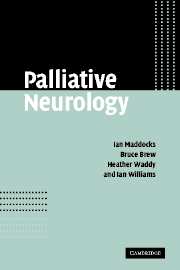Book contents
- Frontmatter
- Contents
- Foreword
- Note on drugs and abbreviations
- Section I Palliative Management
- Section II Major discomforts in advanced neurological illness
- Section III Major neurological conditions requiring palliation
- 1 Cerebrovascular disease: stroke
- 2 Demyelinating disease
- 3 Parkinson's disease and related disorders
- 4 Dementia
- 5 Amyotrophic lateral sclerosis (motor neurone disease)
- 6 Incurable Infections of the nervous system
- 7 Muscular dystrophy
- 8 Neuropathies
- 9 Huntington's disease
- 10 Cerebral neoplasms
- 11 Sequelae of traumatic brain injury
- Section IV Ethical issues
- Section V Appendices
- Index
8 - Neuropathies
from Section III - Major neurological conditions requiring palliation
Published online by Cambridge University Press: 08 January 2010
- Frontmatter
- Contents
- Foreword
- Note on drugs and abbreviations
- Section I Palliative Management
- Section II Major discomforts in advanced neurological illness
- Section III Major neurological conditions requiring palliation
- 1 Cerebrovascular disease: stroke
- 2 Demyelinating disease
- 3 Parkinson's disease and related disorders
- 4 Dementia
- 5 Amyotrophic lateral sclerosis (motor neurone disease)
- 6 Incurable Infections of the nervous system
- 7 Muscular dystrophy
- 8 Neuropathies
- 9 Huntington's disease
- 10 Cerebral neoplasms
- 11 Sequelae of traumatic brain injury
- Section IV Ethical issues
- Section V Appendices
- Index
Summary
Among the many causes of peripheral neuropathy are diabetes, drug side-effects, human immunodeficiency virus (HIV) infection, leprosy, vitamin deficiency, alcohol abuse and inherited nerve disorders. Very often the underlying pathology is reversible if an underlying cause can be removed, a peripheral nerve having the potential to regenerate over many months. In the interim, and sometimes indefinitely, discomforts must be treated symptomatically. Consequences such as Charcot joints and plantar ulcers may be seen if the distal limb sites are not protected from damage. Autonomic neuropathy causes syncope, bladder atony, anhidrosis and dry mouth. Persistent and severe neuropathic pain requires trial of the response to one or more of the range of drugs in the classes antidepressants, anticonvulsants and antidysrhythmics (pp. 106–107).
Guillain–Barre (GBS) is an acute onset radiculo-neuropathy that is commonly triggered by an infection, Campylobacter jejuni being the most frequent antecedent pathogen.
Cases of GBS commonly progress quickly, but many recover equally quickly. Treatment may be unnecessary in those who are able to walk during the second week of illness, but observation until approximately the 8th day seems appropriate to be certain that the illness does not progress. Mild cases of GBS are likely never to come to the attention of a neurologist. Severe GBS, especially in older people, is often associated with profound wasting and persisting joint immobility.
- Type
- Chapter
- Information
- Palliative Neurology , pp. 183 - 185Publisher: Cambridge University PressPrint publication year: 2005



